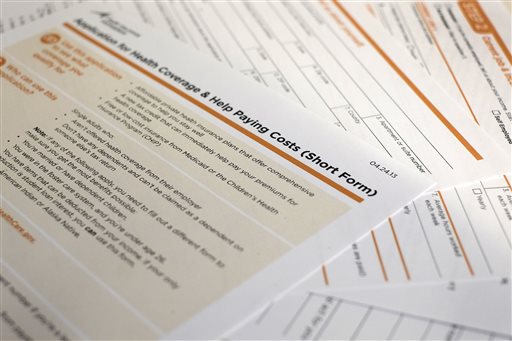WASHINGTON — Getting covered through President Barack Obama’s health care law might feel like a combination of doing your taxes and making a big purchase that requires research.
You’ll need accurate income information for your household, plus some understanding of how health insurance works, so you can get the financial assistance you qualify for and pick a health plan that’s right for your needs.
The process involves federal agencies verifying your identity, citizenship and income, and you have to sign that you are providing truthful information, subject to perjury laws.
You heard it was going to be like buying airline tickets online? Not quite. But even if the process triggers some anxiety, it’s not the government poking in your medical records, as “Obamacare” foes have suggested.
After state health insurance markets open Oct. 1, consumers can apply online, via a call center, in person or by mail. Trained helpers are supposed to be available, but there may not be enough of them.
The main steps are:
- Identify yourself and your family members.
- Provide current information on income, jobs and any available health insurance options.
- Learn how much financial assistance you’re entitled to.
- Shop for a health plan and enroll.
Many people, ranging from lower-income workers to the solid middle class, will qualify for tax credits to help buy a private plan through the state markets. The government will send money directly to your insurer, and you’ll make arrangements to pay any remaining premium.
The poor and near-poor will be steered to Medicaid in states that agree to expand that program.
Here’s an overview of what to expect applying online, with tips:
Visit healthcare.gov and click on “Get Insurance” (here’s the direct link — it’ll open in a popup window so that you can still follow these instructions in the background). The site has links to every state market. You’ll set up an account and password. You’ll provide your contact information and the best way to reach you.
Tip — Treat your password like a bank account or credit card password. It’s not a good idea to set it as “1234567.”
Now you can tackle the actual application. You’ll need birth dates and Social Security numbers for yourself and other family members listed on your federal tax return.
You’ll also be asked if you’re a citizen. Legal immigrants will need their immigration documents.
Tip — You don’t have to plow through the entire application in one sitting. You can save your work and come back later.
Next, you’ll be asked about income.
You may need your most recent tax return, pay stubs and details on other kinds of income, such as alimony, pensions and rents. You can still apply if you haven’t filed a tax return. You’ll also be asked about access to health insurance through your job. You may be required to take that insurance if available.
Your personal and income details will be routed through a new government entity called the data services hub, which will ping agencies like Social Security, Homeland Security and the Internal Revenue Service for verification. The feds will also rely on a major private credit reporting company to verify income and employment.
How smoothly all this works is one of the big unknowns. It could get tedious if discrepancies take time to resolve.
Tip — Provide the most accurate estimate of your expected income for 2014. Lowball the number, and you might see a smaller tax refund in 2015. Overestimate and you won’t get as big a tax credit now.
If you’re like most people, you’ll be getting a tax credit to help pay your premiums. The credits are based on your income and keyed to the premium for a benchmark plan known as the “second-lowest cost silver plan” in your area.
With your tax credit, you can finally shop for insurance. Beware: you’ll probably have to live with your decision until the next annual enrollment period.
You’ll have up to four levels of coverage to consider: bronze, silver, gold and platinum. Plans at every “metal level” cover the same benefits and have a cap of $6,350 a year in out-of-pocket expenses for an individual, $12,700 for families.
Bronze plans generally have the lowest premiums, but cover only 60 percent of medical costs on average. Policyholders will pay the difference, up to the annual out of pocket cap. Platinum plans have the highest premiums, but cover 90 percent of costs. Young adults up to age 30 can pick a skinny “catastrophic” plan — but you can’t use your tax credit on a catastrophic plan.
Tip — Make sure your doctors and hospitals are in the plan you pick. You may have to check the plan’s own website, or call your doctor.
Tip — Your share of the premium could be lower — even zero — if you apply your tax credit to a bronze plan. It’s because the credit is keyed to the cost of a silver plan, which is generally more expensive.
Tip — Check if you are eligible for “cost-sharing subsidies,” in addition to your tax credit. Extra help with out-of-pocket costs is available to people with modest incomes. But only with a silver plan.
Head spinning?
Richard Onizuka, director of the Washington state market, says picking a plan could be the most difficult step. Most of his customers were previously uninsured, so insurance jargon could seem like a foreign language.
“The biggest challenge for consumers will be understanding health insurance and how to purchase it,” he said.
Send questions/comments to the editors.


